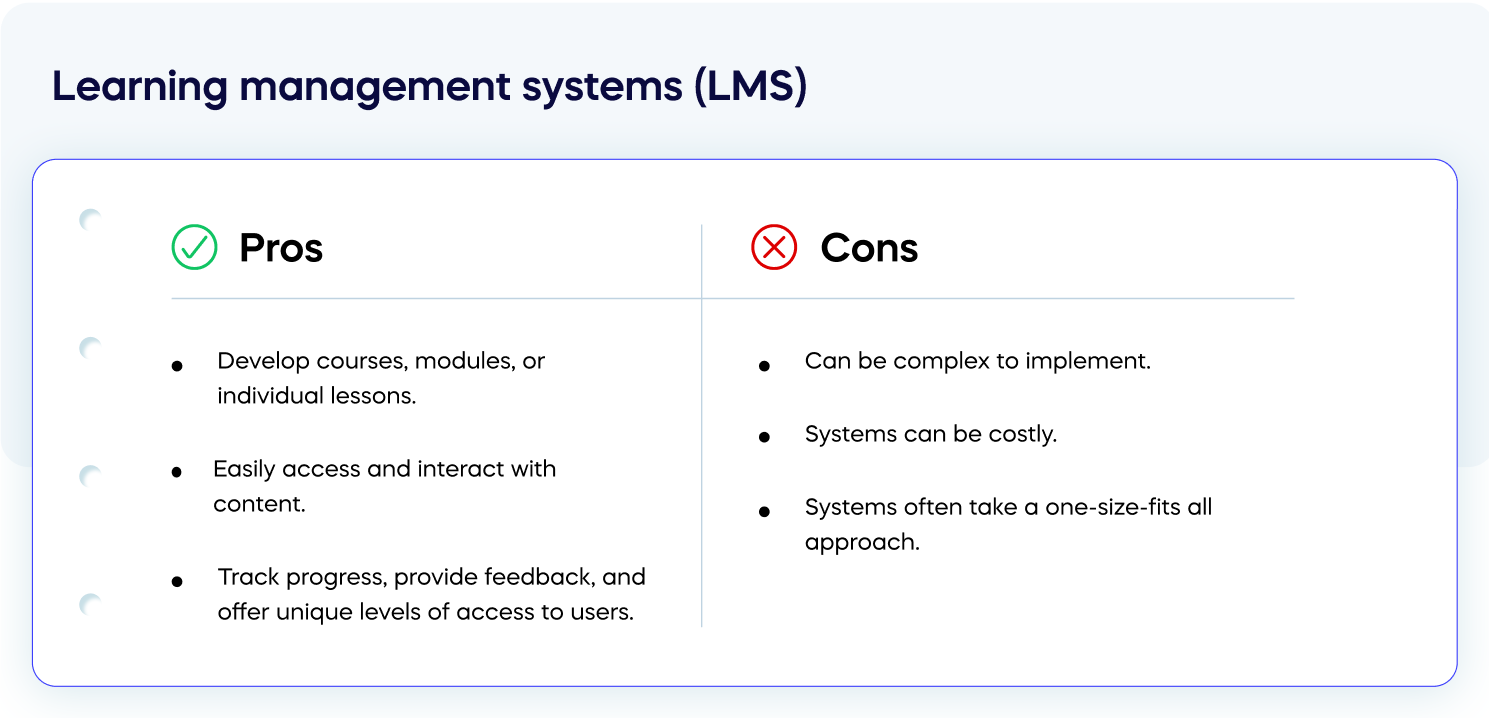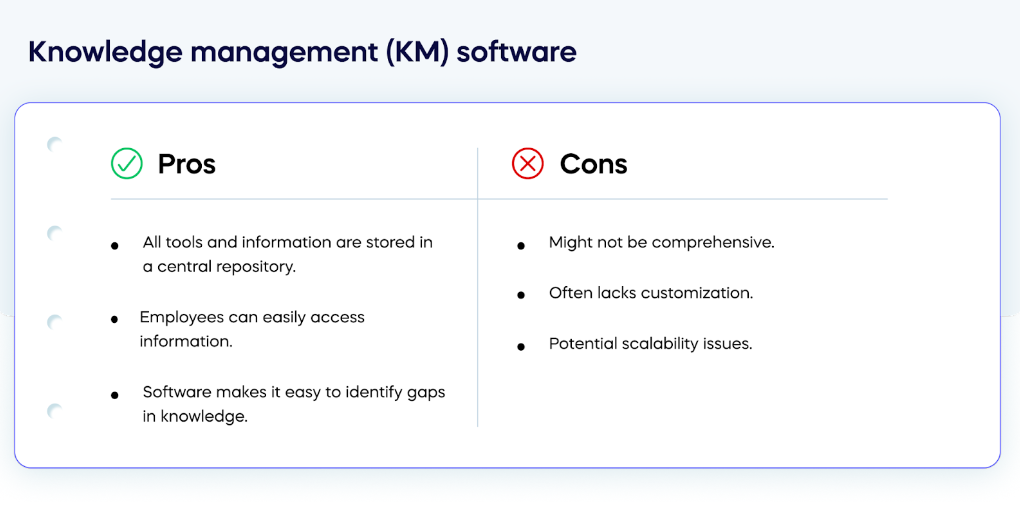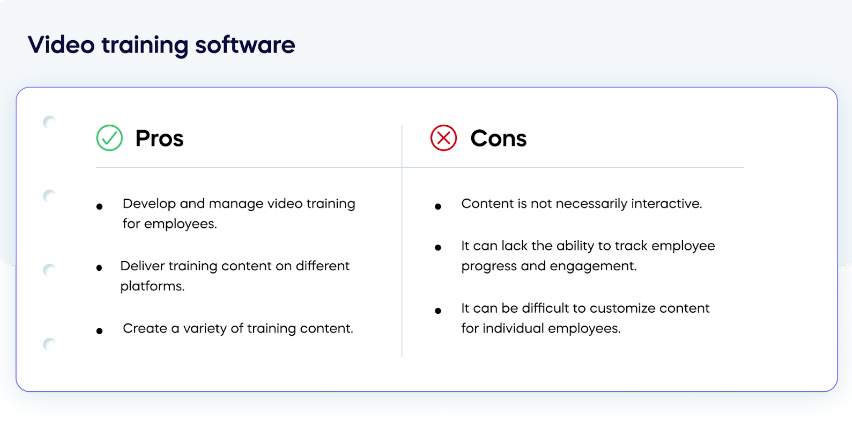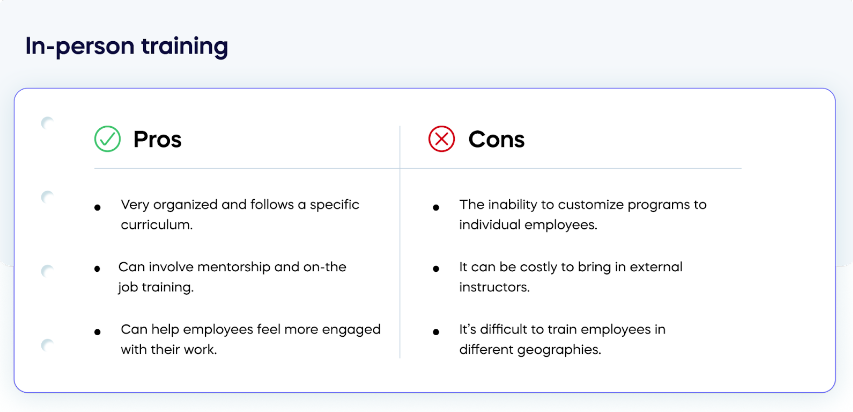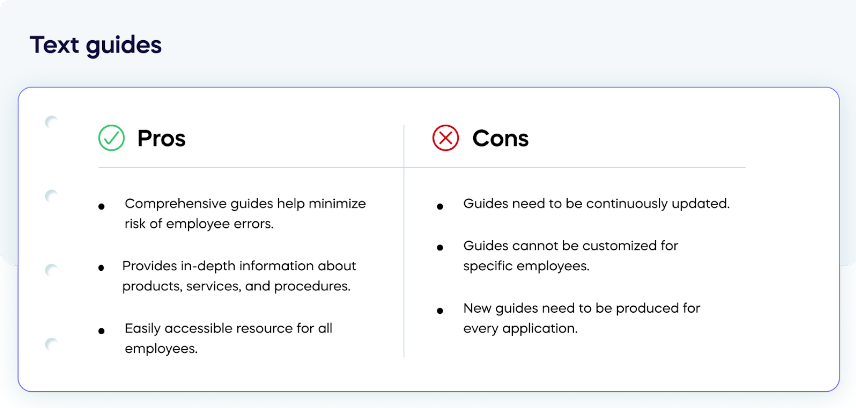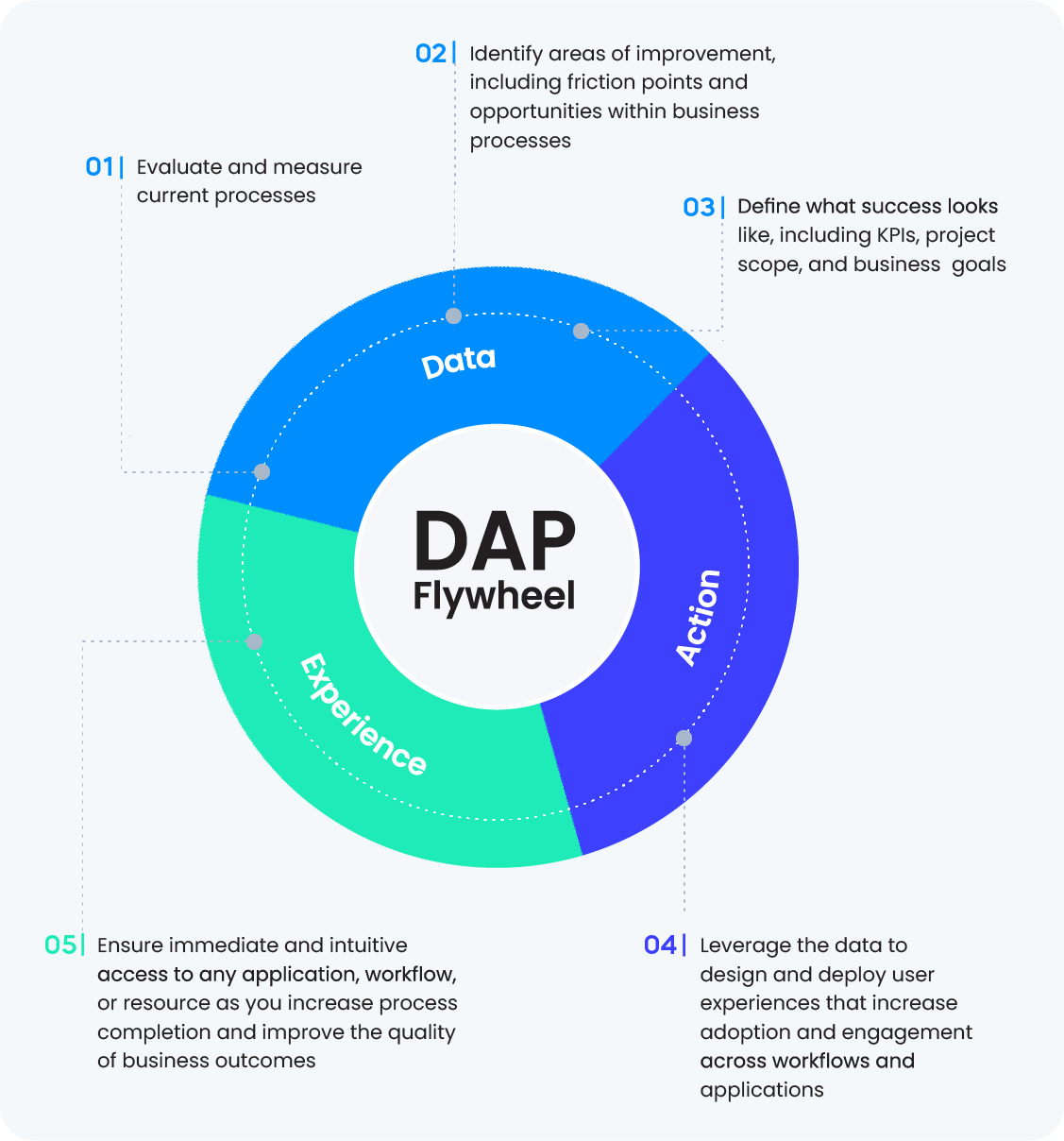Digital transformation is now recognized as a strategic business KPI, with enterprises of all sizes looking for the best ways to maximize the value of their digital assets. Doing so, however, is easier said than done. With a variety of methods to execute digital transformation, choosing the one that best suits your business needs can be challenging.
As noted in The Forrester New Wave™: Digital Adoption Platforms, Q4 2022, “Today’s enterprise digital transformation initiatives deal with more complex customer- and employee-facing application layers. Overwhelming software sprawl makes it difficult to understand and manage application adoption, usage, experience, and performance”.
To give you a better idea of your options when it comes to digital transformation, we’ll be going over the pros and cons of the following WalkMe alternatives, including specific use cases:
- Learning management systems (LMS)
- Knowledge management (KM) software
- Video training tools
- In-person training
- Text guides
Lastly, we’ll take a look at digital adoption platforms (DAP) and the different ways they can be used to optimize digital assets.
We hope that the information in this blog will contextualize your options, enabling you to make an educated decision as to how to proceed on your enterprise’s digital transformation journey.
What are WalkMe alternatives?
WalkMe alternatives include a variety of products all designed to facilitate different aspects of digital transformation. When researching the best option for your business, you’ll want to take into account the following:
- Cost – Does the solution fit your budget?
- Scalability – Is your solution able to scale up as your enterprise grows? Can you use it across different departments?
- Complexity – How difficult is it to implement your solution? Will you need an external team or can everything be done internally?
- Data management capabilities – What kind of data will your solution provide with regards to your enterprise’s digital transformation progress?
- Customization – Can you customize your solution based on the needs of different departments? Can you easily update your solution to adapt to new software?
To shed some light on these questions, let’s break down some of the most popular alternatives to WalkMe.
Learning management system (LMS)
Enterprise learning management systems (LMS) are alternative digital transformation software platforms that provide businesses with a way to create and deliver learning experiences. These experiences can be in the form of courses, modules, or individual lessons. LMSs also provide employees with a way to access and interact with this content.
Features that are common to most LMSs include the ability to track progress, provide feedback, and offer unique levels of access to different users.
Despite their benefits, enterprise learning management systems have several potential downsides. Some LMSs are too complex and costly to be used effectively in most business settings, while others promote a one-size-fits-all approach to education that does not account for the unique needs of individual employees.
Knowledge management (KM) software
Enterprise knowledge management (KM) software is designed to help organizations capture, store, and share information. By centralizing knowledge in a single repository, this type of software makes it easy for employees to find the information they need, when they need it.
In addition, KM software can help organizations keep track of who knows what, and identify gaps in knowledge. This can be particularly helpful in large organizations, where knowledge is often spread across different departments and locations.
KM software typically includes document management, search, and collaboration tools, which help to organize and store information in a central repository while enabling employees to find the information they need.
When choosing enterprise KM software, it is important to consider potential downsides. Some software solutions are more comprehensive than others, and some are more customizable. It is also important to consider the scalability of the software to ensure that it can grow with your organization.
Video training software
Enterprise video training software is a WalkMe alternative that helps businesses develop, manage, and deliver video-based training to their employees. Enterprise video training software can be used to create a variety of training content, including employee onboarding videos, product training videos, safety training videos, and more.
There are a few key considerations when choosing video training software:
- Is the platform easy to use and does it allow you to create engaging and interactive video content?
- Does the software allow you to track employee progress and engagement?
- Is the software flexible and does it enable you to create a variety of training content to cater to the needs of individual employees?
In-person training
Enterprise in-person training is an alternative type of educational development designed to help employees learn new skills or improve existing ones. It typically takes place at the workplace, and can be either structured or unstructured.
Structured enterprise in-person training is highly organized, and usually follows a specific curriculum. Unstructured enterprise in-person training is more flexible, and may involve informal learning activities such as mentorship or on-the-job training.
In-person training can be an effective way to improve employee productivity and retention. It can also help employees feel more engaged with their work, and better equipped to handle challenges.
Potential downsides to in-person training include:
- The inability to customize programs to individual employees.
- The cost of bringing in external instructors.
- The difficulties in training employees based in different geographies.
Text guides
Employee training text guides help to ensure that employees are properly trained and knowledgeable about the company’s products, services, and procedures. By having a well-written and comprehensive employee training text guide, businesses can minimize the risk of errors and accidents, and improve overall efficiency.
When developing a text guide, it is important to consider the company’s needs and objectives. The content of the guide should be relevant and useful to employees, and should be presented in an easy-to-understand format. In addition, guides should be updated on a regular basis to ensure that they remain accurate and relevant.
While employee training text guides can be valuable enterprise assets, they can be problematic. Enterprises consistently adopt new applications, making it imperative to continuously update guides. Additionally, guides are essentially a one-size-fits-all solution – they cannot be customized for specific employees, meaning comprehension can be an issue.
DAP vs. alternative digital transformation methods
As noted in WalkMe’s 2022-2023 State of Digital Adoption report, 60% of enterprises now say that change management programs are “no longer fit for purpose”. Furthermore, 63% claim that a one-size-fits-all approach to technology support and training “isn’t applicable”.
Compared to WalkMe competitors, DAPs provide enterprises with the flexibility they need to successfully implement their digital transformation and change management strategies. DAPs serve as invisible overlays on top of enterprise applications, providing employees with tools, including customizable training, self-service resources, and task automation, to adapt to new software and workflows.
With employee experience directly tied to key business KPIs, including workforce improvement, risk reduction, and compliance and productivity, enterprises are increasingly turning to DAP to help manage their applications.
The 2022 Gartner® Market Guide for Digital Adoption Platforms forecasts that “By 2025, 70% of organizations will use digital adoption platforms across the entire technology stack to overcome still insufficient application user experiences”.
When comparing DAP to alternative digital transformation methods, several points stand out:
- DAP is there when you need it – Unlike LMS and KM software, DAP is always on, running on top of of any enterprise application. Whenever a user needs assistance, DAP is there to lend a hand.
- DAP is contextual – DAPs use specific tools, including in-app walkthroughs, product tours, software analytics, and task automation to provide optimal and contextual user experience.
- DAP is personalized – DAPs are unique amongst digital transformation methods because they can be personalized for different user segments on individual applications. This ensures that employees get the help and training they need when they need it.
- DAP accelerates onboarding – DAPs offer new employees self-service training that accelerates time-to-competency with task specific training. Furthermore, they provide the ability to monitor usage, proficiency, and pain points to ensure proper onboarding.
The WalkMe difference
WalkMe differentiates itself from its competitors in several key ways, making it the preferable choice for enterprises looking to accelerate their digital transformation efforts while maximizing software ROI. Our philosophy is based on three pillars: data, action, and experience, which ensure a flywheel motion of ongoing digital optimization.
As a result of this process, WalkMe is able to provide the following benefits when executing your digital transformation strategy:
Scalability
While WalkMe competitors, like KM software and text guides, often lack the ability to meet the needs of a growing enterprise, our DAP is designed for scale. Specific features include:
- Easy onboarding – Easily onboard non-technical users using our low-code platform.
- Pre-built solutions – Quickly deploy WalkMe’s DAP across your entire tech-stack using pre-built templates, reducing the resources you need to spend on your digital adoption efforts.
- Rapid problem resolution – Identify changes in any underlying application and get a bulk replacement mechanism to address problems quickly.
Agility
With the average enterprise adding 17 new applications every year, it’s critical to maintain an agile workforce that’s able to quickly adapt to change. As opposed to text guides and video training software that needs to be continuously updated, WalkMe’s DAP provides contextual in-app guidance, employees and customers the ability to quickly learn about new processes without wasting time and resources.
Customization
Given that users learn and absorb information differently, digital transformation requires customizable training that reflects the needs of individual employees. WalkMe alternatives are largely static, in that they need to be manually updated for every new piece of software. Conversely, DAPs are inherently customizable.
WalkMe uses an advanced artificial intelligence engine that analyzes user behavior. Custom recommendations are then given on how to improve user experience and increase software adoption.
Visibility into software usage
While certain WalkMe competitors, namely LMSs, use data to track user progress, DAPs offer unmatched visibility into how work gets done. Measure software usage, see where employees get stuck and make mistakes, and take corrective action.
Why WalkMe?
As the only enterprise-ready DAP solution designed for scale with built-in agility, WalkMe provides its customers with the tools they need to accelerate their digital transformation efforts. In addition, we are the most mature DAP vendor in the market, with over 40% market share.
Everest Group recently recognized WalkMe as the leading DAP vendor for the third year in a row, while The Forrester New Wave™ Digital Adoption Platforms, Q4 2022 named us a Leader in DAP.
Our data-driven methodology includes personalized dashboards that provide visibility across entire tech-stacks, along with actionable insights to boost adoption. This ensures that users can measure the impact of digital adoption on software ROI.
Additionally, WalkMe’s partner ecosystem provides enterprises with a host of tips and best practices for boosting software ROI. We provide extensive DAP training and certifications to ensure you utilize the digital adoption strategy that best suits your enterprise’s needs.
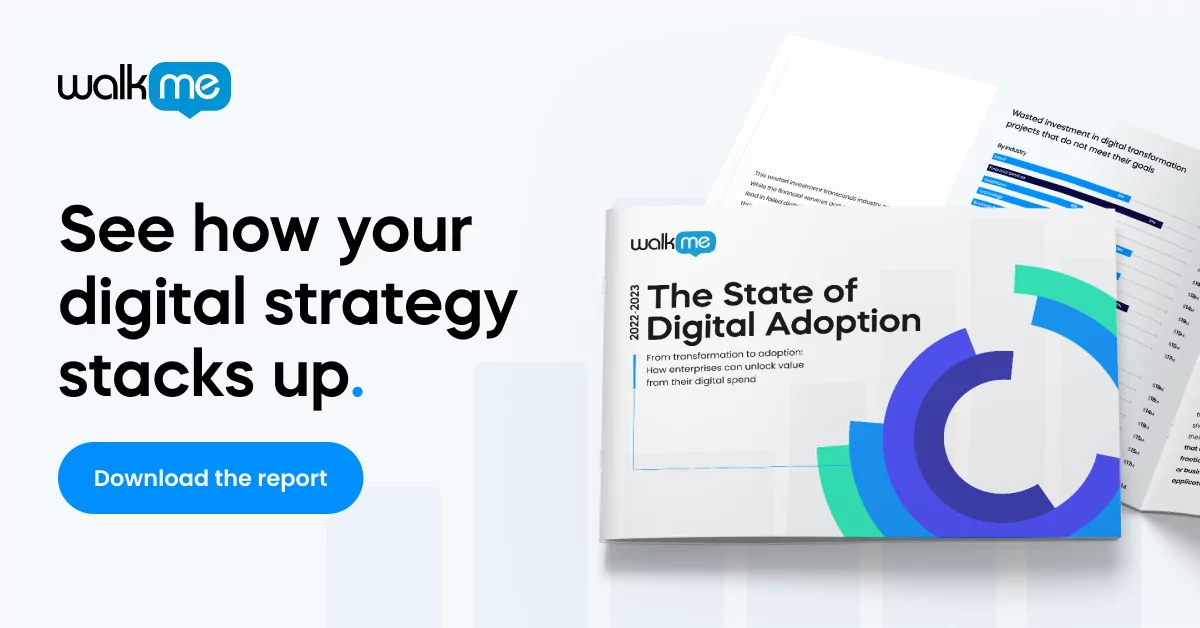
FAQ
WalkMe pricing is designed to fit organizations of all sizes, which is why it varies depending on the plan you choose. Generally, our plans are priced according to features and usage level. This structure makes it possible for customers to get the most out of their WalkMe experience and ensures that companies of any size can find a pricing package that works for them.
Additionally, WalkMe offers packages tailored to your specific needs depending on volume and product use cases. With these options, you can make sure you’re investing in exactly what you need at an affordable price point.
As the creator of the first DAP, WalkMe has developed the tools and expertise to deliver a cutting edge digital adoption experience, enabling enterprises worldwide to maximize their tech stacks. Our proprietary technology combined with proven best practices and methodologies ensure an optimized end-user experience.
WalkMe’s data-first approach and analytics capabilities measure the impact of digital adoption on software ROI. Additionally, the WalkMe DAP is unique in its ability to identify changes in underlying software and provide a bulk replacement mechanism to quickly address any issues.


